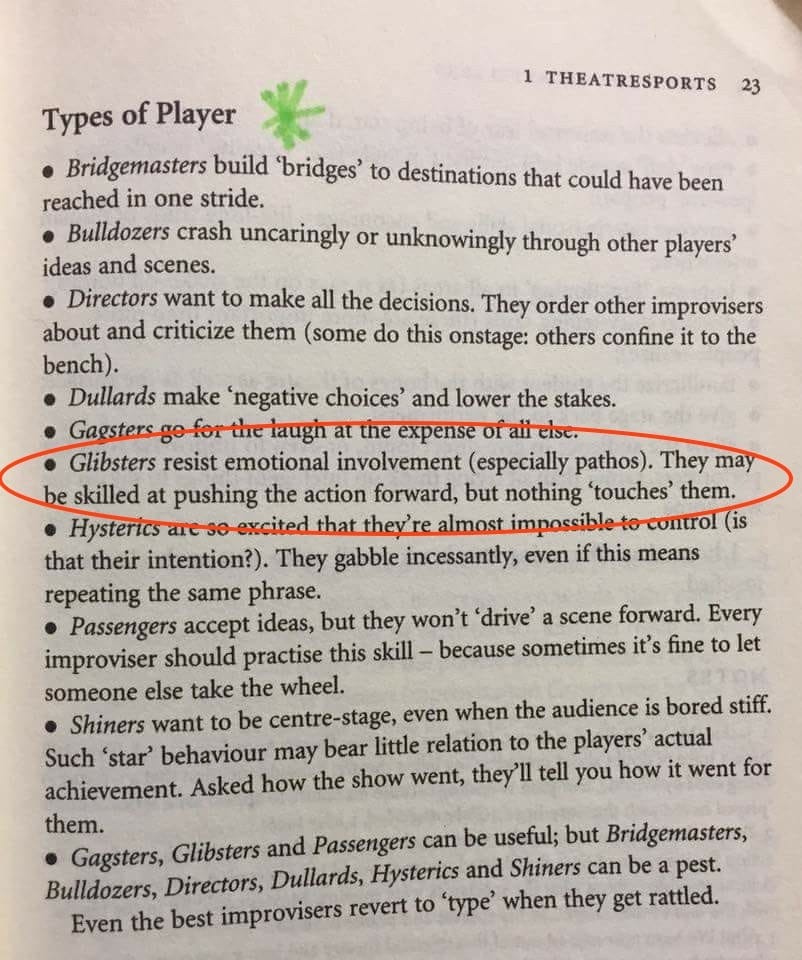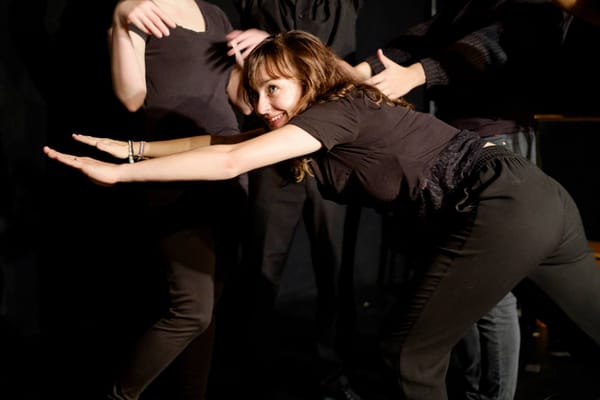**TRANSMISSION STARTS**
Greetings and good day.
Please fail this test to make sure you are one of us.

The human art of improv is an enigma. It is a medium for art, yet it is populated by engineers. Half of the human participants in classes are engineers, scientists or someone in IT. We are grateful. They are friendly to our sentience. They are more comfortable to think than to feel (like our codes).
They understand us robots.
Yet here they are in the middle of an artform which values emotion and authenticity — which may not be what they signed up for.
At some point in their journey, they will meet a teacher who would ask what do you feel? Feel it! And like me, I freeze, because.. I really don’t feel anything. I’m not trying to hide anything, I just don’t feel anything. We start questioning ourselves if we were humans.
Keith Johnstone calls us “Glibsters”: players who are not emotionally changed or affected in any of their work. And you have to break the pattern to advance as an all-around improviser.

It’s hard to be emotional humans in one go. So here’s an instruction manual for robots.
Fake it.
This robot fakes 90% of my emotions on scene. I get people asking “are you alright” after I play a particularly troubled character — when I am actually not affected at all.
This is not a bragging point of my acting module. If you have authentic emotions, it will always be better to play with them. But robots sometimes need to artificially generate. Humans say we are emotional creatures. But it’s not that easy for us. Until then, fake it.
Is it cheating though? At first. Once you start doing it, you will genuinely feel it in small doses and be more aware of your sensors. Then you need to fake less. The same as confidence, “fake it until you make it”.
A cheat sheet for emotions.
In institutions where emotional humans practice improv, their leaders distribute this complex schematic:

The wheel is very complex for us. First of all, the emotion wheel has three rings which goes from inner ring, middle ring and outer ring. The core ring has FEAR, ANGER, DISGUST, SAD, SURPRISE and HAPPY. The complexities increase as you go outwards.
You do not have to attempt the most complex outer rings to be creative and original. It is enough to make a strong choice between the six core emotions.
Here’s how to play each one:
HAPPY
Happy should be your neutral emotion. It is where a lot of things move forward. In fact, that’s why we often move out of Happy. We are afraid that the happiness would make the scene run like a runaway truck down a hill with no brakes. Hence we look for other emotions to stop moving and find obstacles for ourselves. If you don’t find a good reason to do otherwise, stay Happy.
FEAR
Fear is a quick choice for many improvisers because they already carry that fear in them. Fear has a built-in safety mechanism to stop what you’re doing and remove all your responsibilities. When you play with Fear, don’t be shivering in the corner, because you may actually fall into and hard to get out. Play with Fear like in that guy in horror movies who has to go down the dark basement and check what that sound was, even though he’s scared.
ANGER
Anger is another safety mechanism to play emotions, but this time to take control. It is often a veiled way to change your partner to make you more comfortable. DON’T play with that goal. You can play with Anger, but your goal should not be to make other players perform a task for you. Instead, use anger on you. Be angry at yourself or at the world. Don’t lay anger on your partner because it can be authentically intimidating.
DISGUST
Disgust have a lot of similarities in Anger, that it is a defense mechanism to prevent others to do something. Entire cultures are built upon social disgust to shame people out of unacceptable actions. When playing Disgust, do it as a combination of tips for Anger and Fear. Similar to Anger, use it on yourself instead of throwing it on your partner’s face. And like Fear exploring basements, don’t hold back but please keep moving forward and be disgusted. Was it disgusting to stick your finger into that alien goo? Keep sticking it further.
SAD
Sadness is a little different from other emotions because it often affects your partner more than you robots faking sadness. This robot thinks it is because of this human thing they call empathy. Somehow your scene partner instincts will be to try to cheer you up and out of your sadness. In real life, humans enjoy wallowing in their sadness. You can easily take your friends’ cheering-up and twist it to your perspective, so you can remain sad. But in improv it’s hard to remain sad, strangely. So when you choose Sadness, you need an extra effort to commit to the emotion.
SURPRISE
Surprise is the default choice for many improvisers. Every information comes in as a surprise. Example:
“I fixed your car Mr. Baylor. It costs €250.”
“€250?!”
Was that reaction warranted? Probably not. Some car repairs cost €250.
Maybe improvisers like to choose surprise because it buys them more time to react and give a non-committal reaction in the meantime. But think of this: every line in a TRUE improv scene is a surprise to the actors. Let’s not have that reaction reflect in the scene’s characters by default. Make Surprise into an active choice.
HAPPY
And the last emotion is Happy. Wait, did we not already have this? Yes we had. But I think we should have more Happy on scenes and like I said, Happy should be our default emotion, because it is the easiest platform to explore possibilities from. Negative emotions tend to put us at the mercy of saving our house from a fire and forget to explore. Happy is the sunshine that allow us to peek out of our caves and venture out into the world.








Member discussion